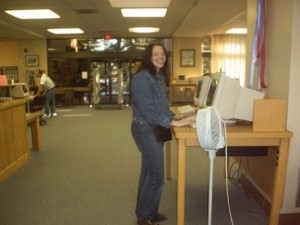Nov
30
2016
So it’s already the week before finals, “Dead Week”. Now I’m sitting here wondering how the heck did I get here and where did all that time go. I haven’t had much a problem with any of my classes. I’ve enjoyed all of them thoroughly from gen-ed courses like English 1020 to CSC 1200. I’ve enjoyed doing the various group work assignments, projects, and presentations. For example, in CSC 1200 we have had a few group projects where we were assigned to created programs in SNAP! and App Inventor. I’ve enjoyed learning how to work on team projects and collaborating with my team mates. I’ve also enjoyed CSC 1200, in general, because I like Professor Ford’s teaching style and him as a person. The way he presents and examples he uses makes the material easy and enjoyable to learn/understand.
Continue Reading »
Nov
30
2016
I have learned an important truth that I like to share with students considering a career in computer science – that a career in computer science can mean a career in almost anything. Computers are everywhere and a part of everything, so there are probably careers that combine computer science with almost any other interest or passion that you have. This is important to me for two reasons – first, because I think far too few students really understand how much of the interesting work in the world today is occurring at the intersection of computer science and some other field (science, engineering, medicine, pharmacology, insurance, manufacturing, and even the humanities) and second, because my life has been profoundly shaped by the accidental discovery of a just such a passion that I continue to combine with computer science.

Photo by Javier Rodriguez Rodriguez (Creative Commons Attribution-Share Alike 3.0)
Continue Reading »
Nov
16
2016
I have worked in a library for nearly 19 years but I’m not a librarian. I began working at the Putnam County library doing typical library stuff – shelving books, checking books in, checking them out, helping with random questions, and learning how to “deal” with every personality (and mental disease) known to man. Once my supervisor found out I was working on my Computer Science degree she allowed me to work on the library’s website. My first website was so very hideous! It was all about how many new cool things I could do! I created it in Microsoft FrontPage (discontinued WYSIWYG HTML editor) which allowed me to easily apply over 1000 different background images, moving Gifs, blinking text, fancy trailing pointer movement, and neon colors. Ok – so I am exaggerating a little (but really….it was bad).

Continue Reading »
Nov
14
2016
A mindset identifies our attitudes towards how we perceive the world and the situations that we encounter within it. Indeed, a mindset defines the culture of a community and can often foreign to outsiders or new members. For instance, take the example of the difference between a western mindset and an eastern mindset. A western mindset emphasizes the individual while the eastern mindset emphasizes the group. This is best illustrated by the opening ceremonies of the 2008 Summer Olympic games when it was reported that while it appeared that a beautiful young girl was singing the song “Ode to the motherland” that she was merely lip-syncing to the voice of another girl that was off stage [1]. While many in the Western world were appalled at this practice, claiming that it was demeaning to both girls, others in the Eastern world claimed that the song was performed in this way for the good of the nation. The differing mindsets defined the interpretation of the performance of the song just as our mindset defines our interpretation of how we approach social situations within interpersonal, small group, and large group interactions. In relativist terms, the appropriateness of the lip-syncing practice was culturally determined.
Academic departments are constantly faced with micro and macro clashes between culture that are rooted in the mindset by which the members of the community have either learned via observation and socialization, or have brought into the environment by way of their own external experiences and expectations. According to Seidman, a characteristic that distinguishes the nature of an organizational culture is communication – specifically, how information is created, communicated, and used [2]. Unfortunately, very rarely do we ever formalize the ways in which we create, communicate, and use that information. Instead, we expect that faculty, staff, and students will learn the norms through interactions with others – first as novices but eventually as full members of the community.

Growth/Fixed Mindset from Dweck [3]. Image from CSU Health Network [http://health.colostate.edu/growth-mindset-event/].
Nov
04
2016
Innovation is the crucial gear that drives engineering and technological revolution alike. Through innovation, the world has seen major breakthroughs in science and research in the past and the present. The curious aspect of innovation is that it makes it extremely hard to predict the future needs and wants of people. Take for instance the internet. Pre-internet, engineers would not have expected to people to need so much technology in their life. Post-internet, engineers could not imagine creating something that is not in some way related to connectivity or communication one way or another. In this way, predictions that were made for the class of 2020 concerning curriculum and research more than 5 years ago are simply not true to reality. Innovation in the world has formed wall that keeps us blind to the future.
Continue Reading »


